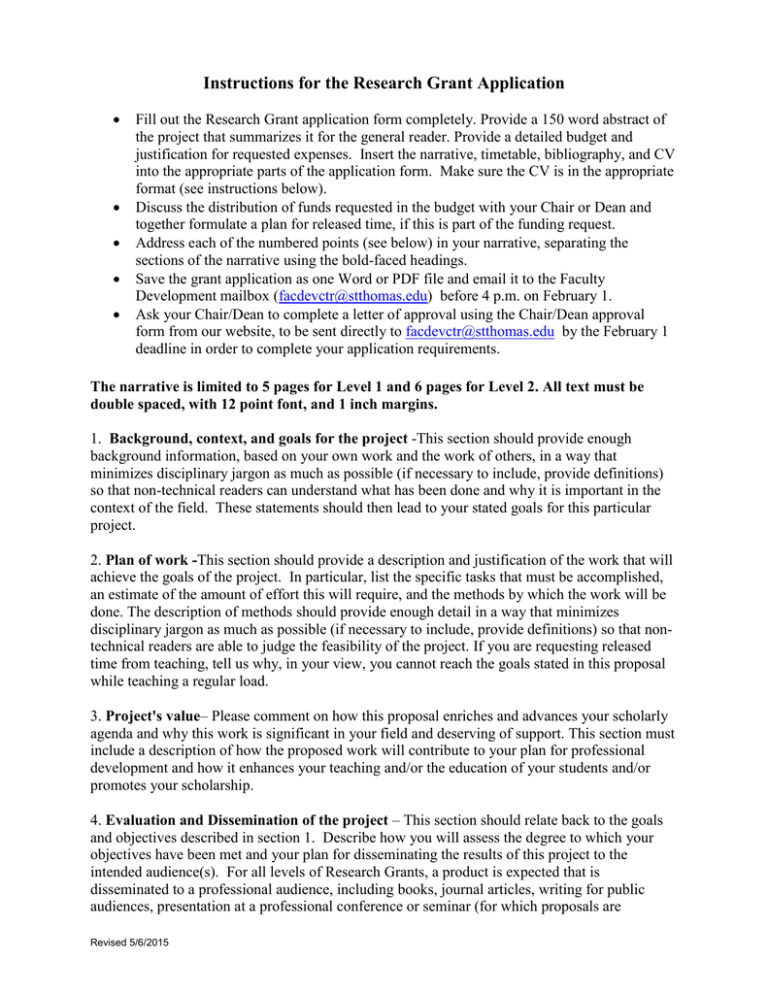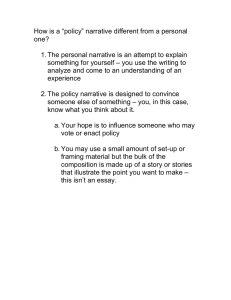Research Grant Instructions
advertisement

Instructions for the Research Grant Application Fill out the Research Grant application form completely. Provide a 150 word abstract of the project that summarizes it for the general reader. Provide a detailed budget and justification for requested expenses. Insert the narrative, timetable, bibliography, and CV into the appropriate parts of the application form. Make sure the CV is in the appropriate format (see instructions below). Discuss the distribution of funds requested in the budget with your Chair or Dean and together formulate a plan for released time, if this is part of the funding request. Address each of the numbered points (see below) in your narrative, separating the sections of the narrative using the bold-faced headings. Save the grant application as one Word or PDF file and email it to the Faculty Development mailbox (facdevctr@stthomas.edu) before 4 p.m. on February 1. Ask your Chair/Dean to complete a letter of approval using the Chair/Dean approval form from our website, to be sent directly to facdevctr@stthomas.edu by the February 1 deadline in order to complete your application requirements. The narrative is limited to 5 pages for Level 1 and 6 pages for Level 2. All text must be double spaced, with 12 point font, and 1 inch margins. 1. Background, context, and goals for the project -This section should provide enough background information, based on your own work and the work of others, in a way that minimizes disciplinary jargon as much as possible (if necessary to include, provide definitions) so that non-technical readers can understand what has been done and why it is important in the context of the field. These statements should then lead to your stated goals for this particular project. 2. Plan of work -This section should provide a description and justification of the work that will achieve the goals of the project. In particular, list the specific tasks that must be accomplished, an estimate of the amount of effort this will require, and the methods by which the work will be done. The description of methods should provide enough detail in a way that minimizes disciplinary jargon as much as possible (if necessary to include, provide definitions) so that nontechnical readers are able to judge the feasibility of the project. If you are requesting released time from teaching, tell us why, in your view, you cannot reach the goals stated in this proposal while teaching a regular load. 3. Project's value– Please comment on how this proposal enriches and advances your scholarly agenda and why this work is significant in your field and deserving of support. This section must include a description of how the proposed work will contribute to your plan for professional development and how it enhances your teaching and/or the education of your students and/or promotes your scholarship. 4. Evaluation and Dissemination of the project – This section should relate back to the goals and objectives described in section 1. Describe how you will assess the degree to which your objectives have been met and your plan for disseminating the results of this project to the intended audience(s). For all levels of Research Grants, a product is expected that is disseminated to a professional audience, including books, journal articles, writing for public audiences, presentation at a professional conference or seminar (for which proposals are Revised 5/6/2015 competitively reviewed), external grant proposals, professional practice and consulting, software products, or other output defined by Boyer (Scholarship Reconsidered, 1990) or UST’s Faculty Handbook. State specific journal, publisher, conference titles, considered as potentials for dissemination. 5. Appendices – please list appendices on separate pages 1. A detailed Timetable for the project, showing tentative plans for initiation, duration, and completion of the proposed work. This can be in tabular or narrative form, but is limited to one page. 2. A Bibliography in two sections: A) Works Cited in the “Background, Context, and Goals” section of the narrative portion of the proposal; and B) Relevant Literature integral to the project but not cited specifically in the narrative. The latter category is intended to demonstrate applicant familiarity with the current literature and readiness to engage in the project. 3. An up-to-date Curriculum Vitae (four page limit, single spaced) that is organized with the following information: o name, department and contact information (phone, email, mailbox) o education (years and degrees) o academic appointments (years and titles) o grants and other honors or awards (last 10 years); o publications (last 10 years); o other professional activity relevant to the project (e.g., consultancies, travel, organizational leadership, collaborations). Revised 5/6/2015

